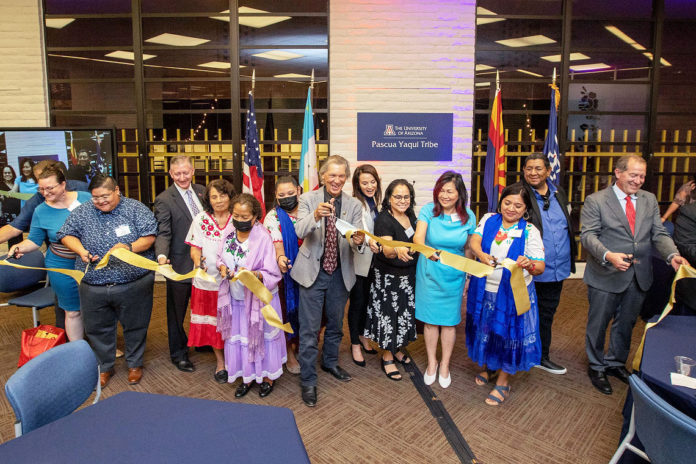
TUCSON, AZ – A new University of Arizona (UArizona) microcampus will serve the Pascua Yaqui Tribe in Tucson, giving tribal members what leaders called a “homecourt advantage” to complete college degrees and certificates and access university technology, research and tutoring services.
The university celebrated the grand opening of the microcampus with a ribbon-cutting ceremony in the newly renovated, 5,000 sq. ft. space, which sits just east of the tribal reservation, formerly housing the Hohokam Middle School.
“This new University of Arizona location designed to serve the Pascua Yaqui Tribe represents a significant milestone in our ongoing commitment to Native American communities – especially those whose traditional homelands include Southern Arizona,” said University of Arizona President Robert C. Robbins. “It has been a goal of mine for years to establish a campus for every tribe in the state and I hope this will be the first of many.”
In-person attendees included Pascua Yaqui Tribal Chairman Peter Yucupicio; members of the Pascua Yaqui Tribal Council; Regent Cecilia Mata, Secretary of the Arizona Board of Regents; Levi Esquerra, UArizona Senior Vice President for Native American Advancement and Tribal Engagement; Marc Miller, Dean of the James E. Rogers College of Law; and José Francisco Calí Tzay, the United Nations’ Special Rapporteur on the Rights of Indigenous Peoples, who is also a lecturer in the College of Law and Associate Director of the college’s Indigenous Peoples Law and Policy Program’s Human Rights Clinical Programs.
“This is home, and now this is your home here at the microcampus, right here by our reservation where our ancestors have lived for a long time,” said Chairman Yucupicio. “Let’s make this the best place to come and study.”
The new microcampus is the result of a university strategic plan initiative to better serve Native American communities. It is also the latest development stemming from an agreement between the university and the tribe, signed last year, to help tribal members more easily access higher education and workforce training programs.
“That intergovernmental agreement set the foundation for more partnerships with the tribe, and that was one of the most significant steps to getting this microcampus up and running,” said Esquerra. “Today is a celebration, but there’s so much more coming after this. This has opened the doors wide open for more collaboration between the Pascua Yaqui Tribe and the University of Arizona.”
Leaders with the tribe’s education department worked with university leaders to develop the initial curriculum for the microcampus according to the tribe’s priorities to develop its workforce. UArizona will work with tribal leadership and department heads to survey the tribe’s employees, most of whom are Yaqui Tribe members, about which courses they want to take. The tribe has about 19,000 enrolled members, with roughly 5,000 living on the reservation, located on the southwest side of Tucson.
“Today, we celebrate bringing this opportunity home to the reservation, so that no one has to leave if that’s not what they choose to do for themselves,” said Serina Preciado, the tribe’s education director. “We advance the narrative of what it means to be from ‘the rez’ today. I’m happy to say that at Pascua Yaqui, we have world class higher education right in our backyard.”
Selina Martinez, a Yaqui architect, designed the renovations for the microcampus. University and tribal branding were incorporated alongside Yaqui motifs, such as flowers that reference Sea Ania, or Flower World, which represents the beginning of life and the result of hard work in Yaqui tradition and ceremony. A sign outside the new space reads “Huya Miisim” – Yaqui for “Wildcats.”














































